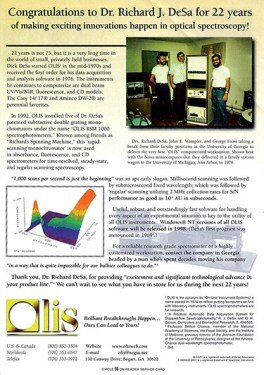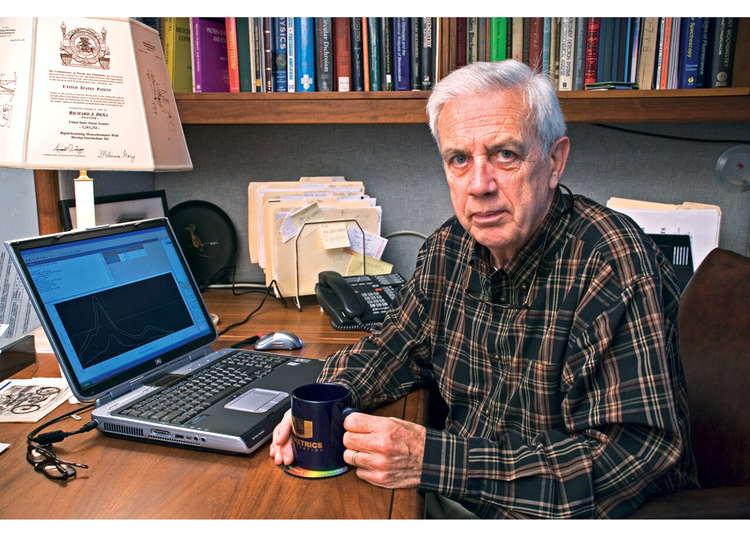Some Ideas on Uv/vis You Should Know
Some Ideas on Uv/vis You Should Know
Blog Article
The 15-Second Trick For Circularly Polarized Luminescence
Table of ContentsLittle Known Questions About Uv/vis.4 Easy Facts About Uv/vis/nir Described8 Easy Facts About Uv/vis/nir Described10 Simple Techniques For Circular Dichroism4 Simple Techniques For Spectrophotometers

Spectrophotometry is most typically used to ultraviolet, noticeable, and infrared radiation, modern-day spectrophotometers can question wide swaths of the electromagnetic spectrum, including x-ray, ultraviolet, noticeable, infrared, and/or microwave wavelengths. Spectrophotometry is a tool that depends upon the quantitative analysis of particles depending upon how much light is taken in by colored substances.
The 10-Minute Rule for Spectrophotometers
A spectrophotometer is typically utilized for the measurement of transmittance or reflectance of options, transparent or opaque solids, such as refined glass, or gases. Numerous biochemicals are colored, as in, they take in noticeable light and for that reason can be determined by colorimetric treatments, even colorless biochemicals can typically be transformed to colored substances ideal for chromogenic color-forming responses to yield compounds suitable for colorimetric analysis.: 65 However, they can likewise be developed to determine the diffusivity on any of the listed light ranges that generally cover around 2002500 nm utilizing various controls and calibrations.
An example of an experiment in which spectrophotometry is utilized is the decision of the equilibrium constant of a service. A certain chemical reaction within an option might happen in a forward and reverse instructions, where reactants form products and items break down into reactants. At some time, this chemical reaction will reach a point of balance called a balance point.
Excitement About Circular Dichroism
The quantity of light that passes through the service is indicative of the concentration of certain chemicals that do not enable light to pass through. The absorption of light is because of the interaction of light with the electronic and vibrational modes of particles. Each kind of molecule has a private set of energy levels associated with the makeup of its chemical bonds and nuclei and thus will soak up light of specific wavelengths, or energies, resulting in special spectral residential or commercial properties.
Making use of spectrophotometers spans numerous clinical fields, such as physics, products science, chemistry, biochemistry. UV/Vis/NIR, chemical engineering, and molecular biology. They are commonly utilized in lots of markets including semiconductors, laser and optical manufacturing, printing and forensic examination, as well as in labs for the study of chemical substances. Spectrophotometry is often utilized in measurements of enzyme activities, decisions of protein concentrations, decisions of enzymatic kinetic constants, and measurements of ligand binding reactions.: 65 Ultimately, a spectrophotometer has the ability to determine, depending upon the control or calibration, what compounds exist in a target and exactly just how much through computations of observed wavelengths.
Developed by Arnold O. Beckman in 1940 [], the spectrophotometer was created with the help of his associates at his business National Technical Laboratories founded in 1935 which would end up being Beckman Instrument Company and ultimately Beckman Coulter. This would come as a solution to the previously developed spectrophotometers which were unable to absorb the ultraviolet correctly.
Not known Facts About Spectrophotometers
It would be found that this did not offer satisfying outcomes, therefore in Design B, there was a shift from a glass to a quartz prism which permitted for better absorbance outcomes - spectrophotometers (https://www.twitch.tv/olisclarity1/about). From there, Model C was born with a modification to the wavelength resolution which ended up having three systems of it produced
It irradiates the sample with polychromatic light which the sample absorbs depending on its properties. It is transmitted back by grating the photodiode variety which finds the wavelength region of the spectrum. Because then, the creation and execution of spectrophotometry devices has increased exceptionally and has become one of the most ingenious instruments of our time.

The Best Strategy To Use For Circular Dichroism
Historically, spectrophotometers use a monochromator consisting of a diffraction grating to produce the analytical spectrum. The grating can either be movable or fixed. If a single detector, such as a photomultiplier tube or photodiode is utilized, the grating can be scanned stepwise (scanning spectrophotometer) so that the detector can determine the light strength basics at each wavelength (which will represent each "action").
In such systems, the grating is fixed and the intensity of each wavelength of light is determined by a various detector in the variety. When making transmission measurements, the spectrophotometer quantitatively compares the portion of light that passes through a recommendation service and a test service, then electronically compares the strengths of the 2 signals and computes the percentage of transmission of the sample compared to the referral requirement.

Report this page